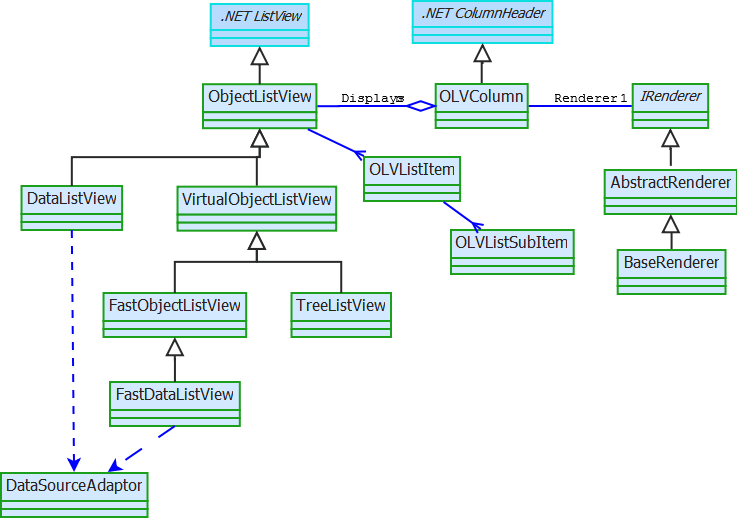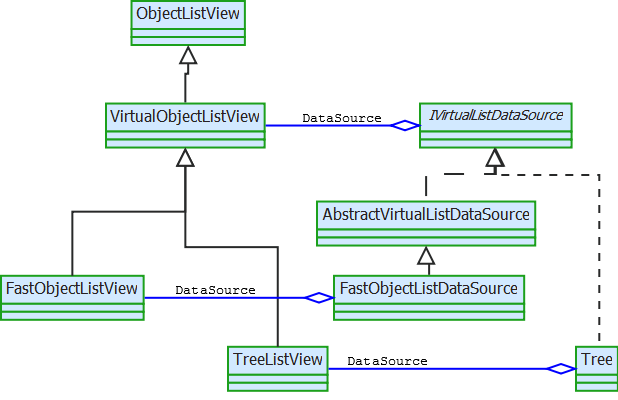Frequently Asked QuestionsJust the FAQs, Ma'am |
Frequently Asked Questions¶
Some questions and issues surface regularly on the Forums or in emails. This section has a selection of the most common questions. Please read the questions before asking questions on the Forum. Several people have been known to have blood pressure problems.
- Can an ObjectListView have rows of different heights?
- Can an ObjectListView fix columns or rows so they don’t scroll?
- How do I hide a column?
- How do I add or remove a column programmatically?
- Why aren’t the checkboxes responding to clicks ?!
- Can I use ObjectListView in a commercial application?
- Why doesn’t the ObjectListView auto-update when I change my model objects?
- Why does VS 2010 complain that BrightIdeasSoftware.ObjectListView can’t be found?
- Why doesn’t it do some-feature-I-really-want?
- Why is the text of the first column indented by about 20 pixels?
- I’ve compiled the project for the first time, but I don’t see the ObjectListView in the toolbox
- Is ObjectListView thread-safe?
- Does it work with Mono?
- Don’t you have some class diagrams for all this stuff?
- How can I add drag and drop to a TreeListView?
Can an ObjectListView have rows of different heights?¶
No.
ObjectListView is a wrapper for the underlying ListView. It makes a ListView much easier to use, but it can’t change the control’s basic behaviour. One limitation of a ListView is it that cannot have rows of different heights. There is no way to make one row be taller than other rows. It’s just not possible.
If being able to have rows of different heights is essential to you, ObjectListView is not your solution.
You may want to consider Matthew Hall’s excellent XPTable and its update project, as well as Lee Paul Alexander’s fantastic Outlook-style list.
Can an ObjectListView fix columns or rows so they don’t scroll?¶
No.
The underlying ListView control doesn’t allow anything like that.
Again, if that ability is essential, you will want to consider one of the above projects.
How do I hide a column?¶
You hide a column by setting IsVisible to false on the column and then calling RebuildColumns() on the ObjectListView:
this.olvColumn2.IsVisible = false;
this.olv1.RebuildColumns();
You cannot hide the primary column (i.e. column 0). If you want to hide the primary column, make it not the primary column, but give it DisplayIndex = 0.
How do I add or remove a column programmatically?¶
Add (or remove) the column to the AllColumns collection and then call RebuildColumns():
OLVColumn aNewColumn = new OLVColumn();
// ... configure it and finally ...
this.olv1.AllColumns.Add(aNewColumn);
this.olv1.RebuildColumns();
If you add the new column directly to the Columns collection, it will vanish when the user switches to Tile view. It also won’t appear in the list of columns available when hiding or showing columns.
Why aren’t the checkboxes responding to clicks ?!¶
This normally happens when the programmer tries to modify a checkbox using .NET’s normal mechanisms. In order to support virtual lists, ObjectListView cannot use those mechanisms – you have to do things the ObjectListView way.
See 10. How do I use checkboxes in my ObjectListView?, especially Using checkboxes programmatically.
Can I use ObjectListView in a commercial application?¶
The ObjectListView code is released under GPLv3. The GPL is a viral license, meaning that if you use some GPL-covered code in your application, your application must also be covered by GPL. This is generally not what commercial developers want. (I am not a lawyer. This is not legal advice. It could be completely wrong).
However, if you wish to use this code in a commercial application, please contact me: phillip.piper@gmail.com .
Why doesn’t the ObjectListView auto-update when I change my model objects?¶
I have ObjectListView that’s showing my model objects. But when I change the values in my model, the ObjectListView doesn’t update. What’s going wrong here?
Nothing. That’s what it is supposed to do.
The ObjectListView knows nothing about your model objects. It does not know when they have been changed. Only you know that. When you know that a model object has changed and needs to be updated, you can either call RefreshObject() to update just one object, or you can call BuildList() to rebuild everything at once.
DataListView is the exception to this rule. Any change you make to your DataSource should be immediately reflected in the DataListView.
Why does VS 2010 complain that BrightIdeasSoftware.ObjectListView can’t be found?¶
I’ve made a new project in Visual Studio 2010 and added the ObjectListView project to my solution. But when I build the solution, it complains that `BrightIdeasSoftware.ObjectListView` can’t be found. What’s going on here?
The default framework for new projects in Visual Studio 2010 is a “Client Profile”. That profile does not contain support for design time components. ObjectListView currently uses design time components to work within the IDE.
To fix this problem, change the target framework of your solution to a “Full” version.
Why doesn’t it do some-feature-I-really-want?¶
It could be that I simply haven’t thought of it. Or it could be that I have thought of it but it just isn’t possible.
Remember that ObjectListView is just a wrapper around ListView. It makes the ListView a little easier to use, and adds some helper functions, but it can’t change the basic behaviour of the control.
Why is the text of the first column indented by about 20 pixels?¶
This shows up when you have a ListView that doesn’t have an icon in the first column. The control still leaves space for the icon, even when there isn’t one.
If the ListView doesn’t have a small image list, this indent disappears. But as soon as the control has a small image list, even an empty one, the text of the first column will be indented.
So, if you really want to get rid of this indent, make an ObjectListView which doesn’t have a SmalImageList. Be aware that some features require a small image list and will create one if necessary. These features are:
- sort indicators on column header on pre-XP systems
- subitem checkboxes
I’ve compiled the project for the first time, but I don’t see the ObjectListView in the toolbox¶
If you are using Visual Studio, check under the Tools>>Options, in the Windows Form Designer category (turn on Advanced settings to see) for a setting “AutoToolboxPopulate.” This should be set to True.
Also, make sure you have a Windows Forms project. ObjectListView is a Windows Forms control: it will not appear in the toolbox for a Windows Presentation Framework project, nor for a WebForms project.
Is ObjectListView thread-safe?¶
“Thread-safe” is a notoriously slippery term.
If you mean, “Can I do whatever I like with an ObjectListView from various threads at the same time?” the answer is “Probably not.”
If you mean “Can I update the ObjectListView from a background thread?” then the answer is, “Yes, so long as you stick to the primary commands.” Specially, these methods can all be called from background threads, and the control will work as expected:
- AddObject/s()
- BuildList()
- ClearObjects()
- InsertObjects()
- RefreshObjects()
- RemoveObject/s()
- SetObjects()
- Sort()
Does it work with Mono?¶
As of September 2009, not any more.
It would be possible to make it work with Mono again. Please let me know if you are interested.
Don’t you have some class diagrams for all this stuff?¶
There seems to be an awful lot going on here. Don’t you have some class diagram so I can see how things fit together?
Some people love class diagrams. Other regard them as just one more piece of out of date documentation. As of v2.1, these diagrams are accurate.
The basic classes are show here:

More details about the relationship between virtual listviews and their data sources can be seen in this diagram:
